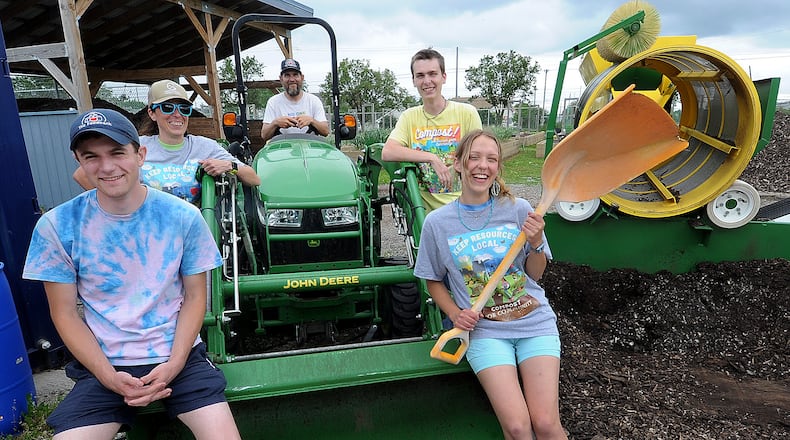The Foodbank garden team has become a staple in the Dayton area, Holman said, serving as an inspiration and role model for equity and sustainability.
The 10-acre garden, which was once an old parking lot next to the warehouse, is home to a small greenhouse for seed starting, a large hydroponic greenhouse for growing lettuce year-round, and an in-vessel composting facility, according to garden team manager James Hoffer. “It’s a diverse farm operation.”
A variety of fruits and vegetables, which include tomatoes, peppers, squash, okra, green beans, peas, garlic and carrots, flourish in 40 outdoor raised beds and other containers, he added. The pretty marigolds help deter rabbits from the nibbling on the beds. Pollinator gardens, too, keep the crew learning, collaborating and working year-round.
Holman said it’s “a spot of beauty in an underserved and blighted area that isn’t just pretty, but beneficial in so many ways to the 45417 zip code as well.”
“I like to think we grow three things at The Foodbank: Ourselves, the community and lettuce,” said team member Bryan Walbridge as he tended to 14 varieties of lettuce in the large hydroponic garden. Other garden team members include Courtney Curtner, Clara Bement and Nathan Vanbeysterveldt.
In the colder months, the team plants seeds in the greenhouse to kick things off and then transplants them to the outdoor containers at the beginning of the growing season.
For more than 40 years, The Foodbank has served as the primary source of food for the hunger relief network in the Miami Valley through a network of partner agencies, according to Hoffer. The Foodbank provides the infrastructure for more than 100 member food pantries, community kitchens and shelters that serve Montgomery, Greene and Preble counties.
The onsite greenhouse was built and fully operational by November 2021, according to Walbridge. It is named after Beverly K. Greene, the late matriarch of the Greene family, who sponsored its planning and construction.
The Beverly K. Greenehouse measures 6,000 square feet, featuring a hydroponic growing system by the Ohio-based company Cropking. More than 100,000 heads of lettuce have been harvested so far, with a current average of 1,400 heads a month, according to Hoffer. The fresh food they grow is solely distributed to more than 100 food pantries and other partner agencies in The Foodbank’s network — in addition to The Foodbank’s onsite weekly Drive Thru.
In 2019, the garden team took the lead in the region by implementing an impressive, in-vessel composting machine. It shelters food waste from pests and harsh weather while creating an optimal environment for composting.
The process within the composter takes anywhere from 14 to 21 days; and the product is then moved to a separate location to “cure” for an additional 30 days. This composting system allows The Foodbank to use food spoilage to create a nutrient-rich soil amendment while diverting it from the landfill.
Not surprisingly, the work does not end here.
The crew members frequent community planning meetings in which they advocate for poorer areas to receive resources that well-off communities typically get.
Hoffer added the team also strives to make The Foodbank’s garden and greenhouse a frequent stop for school field trips, teaching younger generations the importance of taking care of the planet.
The process of growing and distributing fresh greens also provides many educational opportunities for volunteers, employees, interns and anyone interested in taking a tour.
For more information about The Foodbank and its services, visit thefoodbankdayton.org.
About the Author








